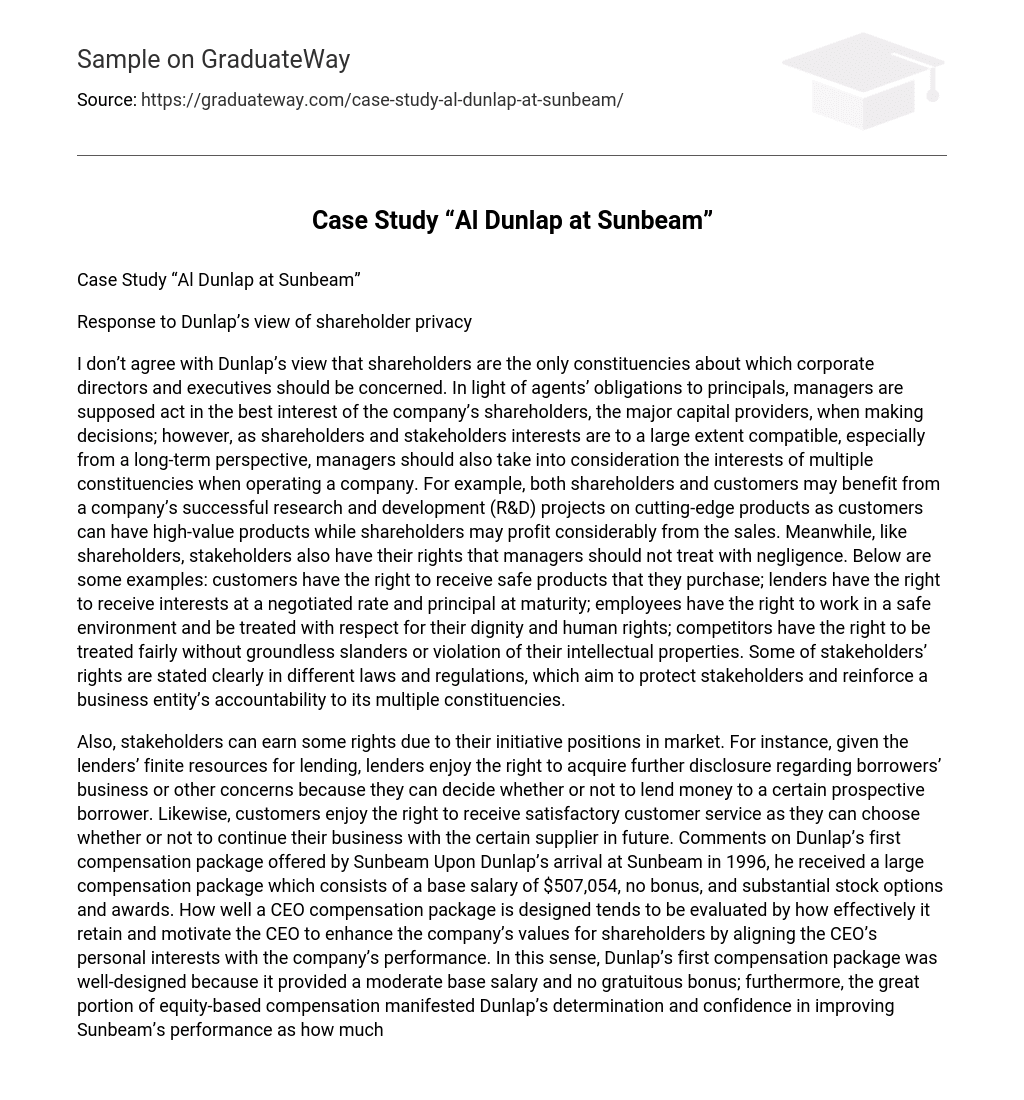Response to Dunlap’s perspective on safeguarding shareholder privacy
Dunlap’s belief that corporate directors and executives should solely prioritize the concerns of shareholders is unfounded. While managers are obligated to act in the best interest of shareholders, they should also take into account the interests of other stakeholders. Shareholders and stakeholders often have aligned interests, particularly in the long run. For instance, successful research and development projects can benefit both customers and shareholders. Additionally, managers must not overlook the rights of stakeholders. Customers have the right to receive safe products, lenders have rights to negotiated interest and principal payments, employees have rights to a secure work environment and respectful treatment, and competitors have rights to fair treatment and protection of their intellectual property. Various laws and regulations explicitly define stakeholder rights with the objective of safeguarding them while promoting a business entity’s responsibility towards its diverse constituents.
The stakeholders in the market earn certain rights based on their positions. For example, lenders can request more information before deciding to lend money. Similarly, customers have the right to satisfactory customer service and can choose whether or not to continue business with a specific supplier. When Dunlap joined Sunbeam in 1996, he received a generous compensation package consisting of a base salary of $507,054, no bonus, and significant stock options and awards. The effectiveness of CEO compensation packages is often measured by how well they incentivize and motivate CEOs to increase shareholder value by aligning personal interests with company performance. In this aspect, Dunlap’s initial package was well-designed, providing a moderate base salary without excessive bonuses. Most of the compensation came from equity-based rewards, reflecting Dunlap’s commitment and confidence in improving Sunbeam’s performance. The amount he could earn depended heavily on the company’s stock price. This package primarily aimed to motivate the CEO and enhance company performance leading to an increase in Sunbeam’s stock price.In addition, providing stock options can demonstrate the CEO’s loyalty and dedication without using significant funds. This approach also decreases agency costs by motivating the CEO to adopt an owner’s mindset and prioritize cost-effectiveness. Moreover, if classified as an “incentive stock option” (ISO) according to IRS regulations, both the company and the CEO may enjoy tax advantages.
While the compensation package for the CEO is not without weaknesses, such as the potential for dangerous behaviors like manipulating earnings or fraudulent reporting, it also had positive aspects. After Sunbeam acquired three other appliance companies, the CEO received a new package that included a doubled base salary and 300,000 shares worth $11,055,000. This increase in compensation was justified as the company grew and aligned the CEO’s interests with those of the company and shareholders. However, shareholders and directors may have overlooked the potential negative effects of this increased equity-based compensation on the CEO’s behavior. Overall, opinions on Sunbeam’s corporate governance were mixed.
In my view, the decision to fire Al Dunlap by Sunbeam’s board was a wise one. This decision showcased effective corporate governance as it prevented further harm to the company’s leadership environment and avoided incurring more agency costs. SEC litigation release No. 17001 disclosed that Dunlap engaged in inappropriate earning management practices, such as channel stuffing and creating “cookie jar” reserves, with the aim of inflating Sunbeam’s revenues and earnings. These actions served as clear indications of a weak leadership climate within Sunbeam. If the board had not acted quickly to terminate Dunlap’s employment, it would have endangered the long-term well-being and prosperity of the company.
The acquisitions of the three problematic companies by Sunbeam did not benefit the company’s shareholders. Instead, it created agency costs between Sunbeam’s shareholders and Dunlap, the CEO at the time. After Dunlap announced his intention to leave during a board meeting, an investigation was conducted by the directors. This investigation revealed severe financial issues that Sunbeam was facing under Dunlap’s leadership. Considering all this information and previous discussion, it is evident that the challenging questions posed by Sunbeam’s directors during the meeting, the thorough investigation conducted afterwards, and the decision to terminate Dunlap as CEO all demonstrate effective corporate governance within the company.





